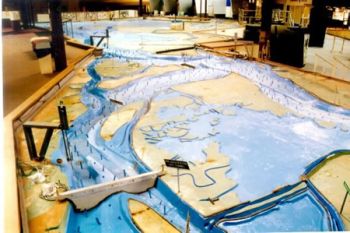Three-Dimensional Hydraulic Models: Difference between revisions
No edit summary |
No edit summary |
||
| (3 intermediate revisions by 2 users not shown) | |||
| Line 1: | Line 1: | ||
__NOTOC__ | __NOTOC__ | ||
[[Category:Hydraulics]] | |||
---- | ---- | ||
<!-- Delete any sections that are not necessary to your topic. Add pictures/sections as needed --> | <!-- Delete any sections that are not necessary to your topic. Add pictures/sections as needed --> | ||
| Line 11: | Line 12: | ||
|caption= | |caption= | ||
<!-- Add picture caption --> | <!-- Add picture caption --> | ||
The USACE Bay Model is one of the most famous and most complex physical hydraulic models ever built. While it was once used for scientific research, it is now a tourist attraction. (USACE) | The USACE Bay Model is one of the most famous and most complex physical hydraulic models ever built. While it was once used for scientific research, it is now a tourist attraction. | ||
(Image Source: [https://www.spn.usace.army.mil/Missions/Recreation/Bay-Model-Visitor-Center/The-Bay-Model-Journey/Trekking-the-Model-Tour/ USACE]) | |||
}} | }} | ||
Three-dimensional hydraulic models are typically used in the study of rapidly-varied flow that occurs along a spillway or bridge pier or in the study of the effects of turbulence and irregular flow geometries on various closed conduit components such as valves or flow meters. There are two types of three-dimensional hydraulic models that can be used | Three-dimensional hydraulic models are typically used in the study of rapidly-varied flow that occurs along a spillway or bridge pier or in the study of the effects of turbulence and irregular flow geometries on various closed conduit components such as valves or flow meters. As a result of the uncertainties in predicting the effects of rapidly-varied flow by using either one- or two-dimensional hydraulic modeling methods, three-dimensional models reduce the uncertainty in this type of turbulent flow and help to achieve a greater level of optimization for a hydraulic design in an [[engineering]] project. There are two types of three-dimensional hydraulic models that can be used depending on the level of analysis and detail required by the study and available funds: | ||
* [[Physical Models]] | |||
* [[Computational Fluid Dynamics (CFD)]] | |||
*[[Physical Models]] | |||
*[[Computational Fluid Dynamics (CFD)]] | |||
<!-- For information on notation for in text citations visit https://www.mediawiki.org/wiki/Help:Cite Or simply enclose the citation as shown <ref> citation </ref> in the location of the in text mention. Citations will automatically populate below--> | <!-- For information on notation for in text citations visit https://www.mediawiki.org/wiki/Help:Cite Or simply enclose the citation as shown <ref> citation </ref> in the location of the in text mention. Citations will automatically populate below--> | ||
Latest revision as of 20:58, 21 July 2023

|
| The USACE Bay Model is one of the most famous and most complex physical hydraulic models ever built. While it was once used for scientific research, it is now a tourist attraction.
(Image Source: USACE) |
Three-dimensional hydraulic models are typically used in the study of rapidly-varied flow that occurs along a spillway or bridge pier or in the study of the effects of turbulence and irregular flow geometries on various closed conduit components such as valves or flow meters. As a result of the uncertainties in predicting the effects of rapidly-varied flow by using either one- or two-dimensional hydraulic modeling methods, three-dimensional models reduce the uncertainty in this type of turbulent flow and help to achieve a greater level of optimization for a hydraulic design in an engineering project. There are two types of three-dimensional hydraulic models that can be used depending on the level of analysis and detail required by the study and available funds:
Citations:
Revision ID: 7425
Revision Date: 07/21/2023
